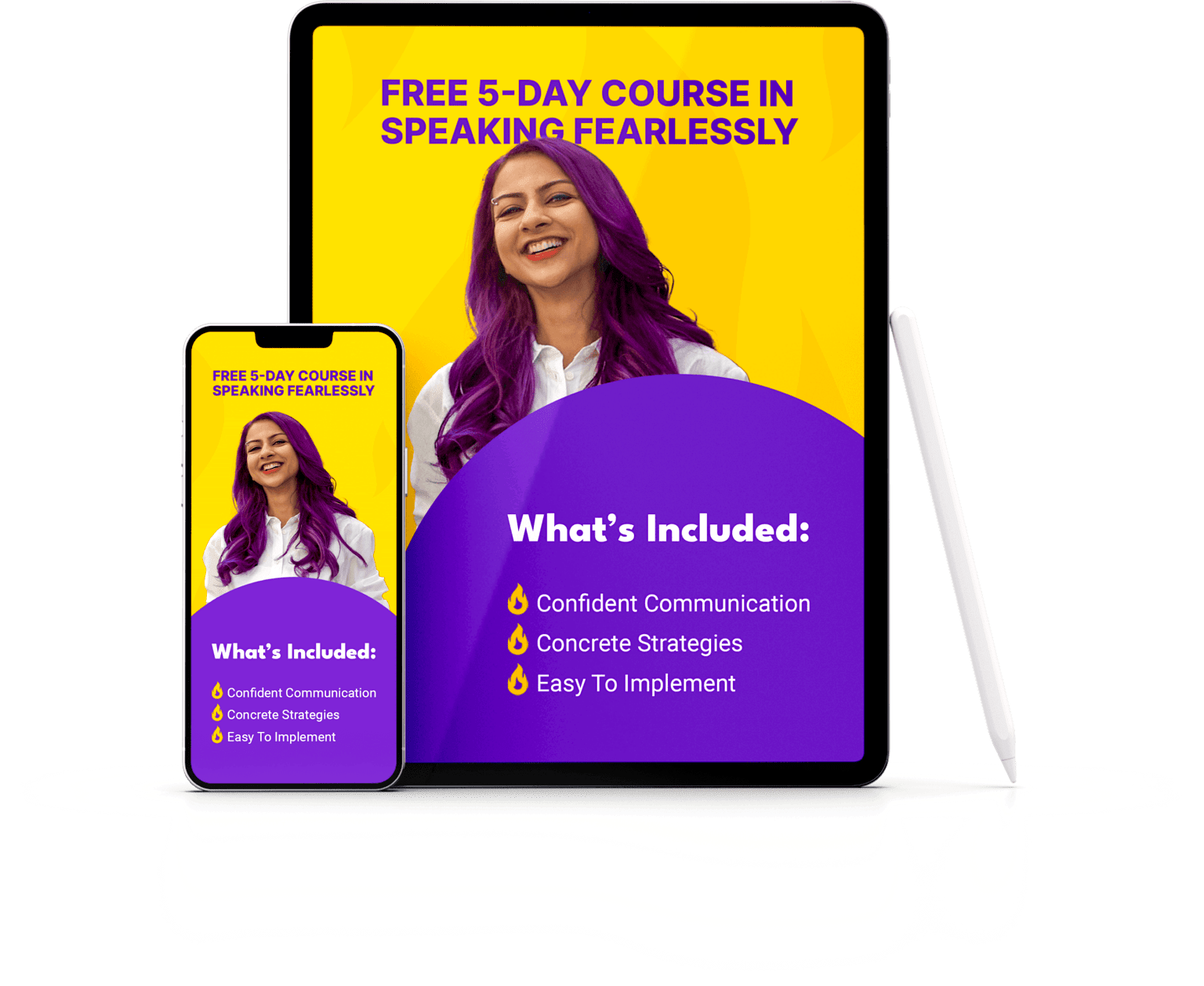Public speaking is a skill that transcends industries and professions. Whether you’re an executive delivering a critical presentation, or an entrepreneur establishing thought leadership through podcasts and talks, the ability to communicate effectively in front of an audience is vital for business and career growth.
In 2023, as the world continues to evolve with new tech, a saturation of “influencers” and changing norms, mastering public speaking remains as relevant as ever. This comprehensive guide will equip you with the tools, techniques, and strategies you need to excel in public speaking on stage or on camera.
Table of Contents

1. Introduction: The Significance of Public Speaking in 2023
Public speaking isn’t just a traditional skill; it’s an evolving art. In 2023, the ability to communicate effectively in front of an audience (or for an imagined audience!) holds immense importance:
- Career Advancement: Professionals who can articulate their ideas persuasively often find themselves on the fast track to success. And conversely – a lot of talented and experienced employees find themselves stuck in their careers because of their fear or ineffectiveness when they speak and present.
Whether you’re vying for a promotion, leading a team, or pitching to investors, public speaking is a key differentiator – and it can become your strength and superpower.
- Academic Pursuits: From classroom presentations to defending a thesis, students benefit from refining their public speaking skills (and overcoming the anxiety of speaking in public). Effective communication enhances their ability to convey their knowledge and ideas – and sets them up for long-term success.
- Influence and Thought Leadership: Influential managers as well as industry thought leaders are often exceptional public speakers. Whether addressing a boardroom, an auditorium or a country, the power of their words leaves a lasting impact.
- Entrepreneurship: Startup founders and business owners rely on their ability to pitch their ideas, products, and services. Strong public speaking skills can attract investors, customers, and partners.

- Personal Development: On a personal level, mastering public speaking can boost self-confidence, improve interpersonal relationships, and enrich social interactions. Being a powerful public speaker can have a wide-reaching impact on your professional and personal life.
As we navigate a world where technology enables communication in diverse ways, from stages and classrooms to podcasts and virtual platforms, the ability to master public speaking is more valuable than ever. In this guide, we will explore every aspect of becoming a masterful public speaker in the year 2023 and beyond.
2. Understanding the Basics
The Foundation of Public Speaking
Before diving into advanced techniques, it’s crucial to understand the core principles of effective public speaking. These principles form the foundation upon which all other skills are built:
- Clarity: Your message must be clear and easy to understand. Avoid jargon, convoluted language, or excessive technical details unless your audience is well-versed in the topic.
Pro-tip: Understanding your audience at a deep level really helps with knowing what kind of jargon and terminology they’ll understand and expect – as compared to jargon that will leave them confused. If you need help, read this post on crafting an engaging presentation.
- Relevance: Ensure that your talk or presentation is relevant to your audience’s interests and needs. Tailor your content to address their concerns and answer their questions.
Some of the worst presentations that I’ve seen are ones that are tone-deaf to their audience’s interests.

- Engagement: Keep your audience engaged by using techniques like storytelling, humor, and interactivity. An engaged audience is more likely to remember and act on your message.
- Confidence: Confidence is essential in public speaking – not just projecting it but also feeling it within yourself. Believe in your message, your expertise, and your ability to communicate effectively. Confidence can be cultivated through practice and preparation.
- Authenticity: Be yourself when speaking in public. Authenticity builds trust with your audience and makes your message more relatable.

Identifying Your Speaking Goals:
Before you start preparing your talk or working on pitching for speaking at that next event, it’s crucial to identify your specific public speaking goals:
- Informative: Are you aiming to inform your audience about a particular topic or concept? Informative speeches provide valuable knowledge and insights and position you as an authority in your industry.
- Persuasive: Are you trying to persuade your audience to adopt a certain viewpoint, take action, or make a decision? Persuasive speeches rely on strong arguments and compelling evidence. These are particularly effective within companies and teams when you want the audience to take a specific action after your presentation.

Image by:
Freepik
Entertaining: Are you aiming to entertain and engage your audience, perhaps at an event or as a keynote speaker? Entertaining speeches often incorporate humor and storytelling.
Educational: If you’re in an educational setting, your goal may be to educate and instruct your audience on a specific subject or skill. Examples of these kinds of speaking engagements are trainings and workshops – with very clear outcomes and objectives.
Motivational: In some cases, you may want to motivate and inspire your audience. Motivational speeches often draw upon personal experiences and anecdotes.
Understanding your speaking goals will guide your content, tone, and delivery style.
Pro-tip: you don’t need to choose just one goal – your talk and speaking style can integrate multiple goals. The key is to be intentional about the goals so that you can shape your material and speaking style to achieve them.
Overcoming the Fear of Public Speaking

One of the most common challenges in public speaking is the fear and anxiety associated with it. The fear of public speaking, known as glossophobia, affects many individuals. However, it’s a hurdle that can be overcome with the right strategies:
- Preparation: Thoroughly prepare your talk or presentation and practice it multiple times. Knowing your material well boosts your confidence.
Practice often gets a bad rap – especially with speakers who pride themselves on improvisation. They are often concerned that practicing will make them sound unnatural or robotic.
But ironically, rehearsed talks only sound rehearsed if they haven’t been rehearsed well or enough. If you know your material inside out, you’re more likely to cultivate that inner confidence and reassurance that will counter the public speaking anxiety that you might be feeling.
- Visualization: Visualize yourself delivering a successful speech. Imagine the positive reactions from your audience.
Visualization can be powerful tool in not just encouraging positive self-talk but also giving you a feel for what it might be like on that stage – so that it doesn’t seem alien and intimidating when you’re up there speaking.
- Breathing and Relaxation: Practice deep breathing and relaxation techniques to calm your nerves before speaking. These exercises can help reduce anxiety.
Create a warmup routine that helps you calm down and get in the zone before you need to speak.
- Positive Self-Talk: Replace negative self-talk with positive affirmations. Remind yourself of your abilities and past successes.

Also remember that you’re there to serve the audience. So if you feel nervous or anxious, remind yourself that what you say can help someone – and you’re showing up for them.
- Gradual Exposure: Start with smaller speaking engagements and gradually work your way up to larger audiences. Each successful experience builds confidence.
When I helped AI influencer Ruben Hassid prepare for several international keynotes, we started him off by going to open mic storytelling events in his hometown. This helped him get gradually comfortable with speaking to a live audience and built his confidence so he felt more prepared to face bigger stages.
- Public Speaking Courses: Consider enrolling in a public speaking course or joining a group like Toastmasters, where you can practice in a supportive environment.

Understanding these foundational principles will set the stage for your journey to mastering public speaking in 2023.
In the next 6 sections of this guide, we will dive deeper into each aspect of public speaking, arming you with the knowledge and techniques needed to excel in a wide range of speaking situations and environments. For more help on this topic, read this post on overcoming the fear of public speaking.
3. Preparation and Planning
Research and Gathering Information
- Effective Research Strategies: Discover how to conduct research efficiently, validate sources, and gather valuable information for your speech or presentation.
Use AI as a starting off point but don’t rely on ChatGPT to come up with your entire presentation – it will never sound like you!
- Visual research: I look for images, graphs, infographics and even memes to go along with my content – and I do this research at the same time as developing the content itself.
This way, the visual nature of the presentation isn’t an after-thought – I’m not using images to decorate my slides but they form an integral part of my message.
Crafting a Powerful Message
- The Power of Storytelling: Explore the storytelling and incorporating compelling narratives into your talks and presentations for maximum impact.
We are hardwired to listen to and remember stories- use that evolutionary development to your advantage.
- Creating Persuasive Arguments: Understand the principles of persuasive communication and how to build strong arguments that resonate with your audience.
Structuring Your Speech
- Mastering Speech Structure: Forget the clichéd advice of “tell them what you’re going to tell them, tell them and then tell them what you’ve told them”. That’s boring.
Instead, look at cold opens – start with an interesting story that throws your audience into the deep end of your message. Explore unconventional structures that keep your audience on their toes.
- Organizational Patterns: Discover different organizational patterns such as chronological, spatial, and problem-solution, and learn how to choose the most suitable one for your talk.
4. Delivery Techniques
Body Language and Non-Verbal Communication
- The Language of Gestures: If you’re delivering a talk in person – try this body language technique: stand firmly grounded with your legs slightly apart, and then animate your upper body.
You can absolutely take a few steps – but do this intentionally and deliberately – not randomly.
Use a variety of gestures to convey confidence and emphasize certain points.
- Effective Use of Facial Expressions: Learn how facial expressions can communicate emotions and engage your audience on a deeper level.
A lot of people suffer from a poker face – they want to convey different types of emotions but aren’t intentional about it.
Voice Modulation and Articulation
- Voice Control and Variability: Understand the importance of voice modulation, pitch, tone, and pace in delivering a dynamic and engaging talk.
You might be more monotonous than you think. If you can vary your pitch, pacing and add in pauses, you’ll greatly enhance the probability of being engaging and understood.
- Articulation and Enunciation: Improve your articulation and enunciation to ensure your message is clear and easily understood by your audience.
Pro-tip: When you enunciate well and clearly, you’re sending the signal that what you have to say is important. Be sure to watch this video on vocal warmups to make this part easier.
The Power of Eye Contact
- Establishing Connection: Eye contact can establish a strong connection with your audience and convey sincerity and confidence.
You can have great eye contact even when presenting online – just focus on the camera when you want the audience to feel like you’re looking at them.
Energy
- A rookie mistake that a lot of inexperienced speakers make is that they forget to “turn on”. They convey low energy, which disengages the audience.
You, as the presenter, are the energy ceiling and floor for your audience. They will either rise to your energy level or sink to it.
It’s up to you to maintain high energy so that the audience is engaged and interactive.
5. Engaging Your Audience
Storytelling Techniques
- Building Engaging Stories: Explore advanced storytelling techniques, including character development, plot structure, and emotional resonance.
- Creating Vivid Mental Imagery: Learn how to paint vivid mental pictures through storytelling, making your narrative more compelling.
Interactivity and Audience Engagement
- Interactive Elements: Discover how to incorporate interactive elements like polls, questions, and discussions to keep your audience engaged and involved.
- Active Listening: Develop your active listening skills to understand your audience’s needs and adapt your speech accordingly.
It’s up to you to engage your audience intentionally so that they’re not wandering off to check their emails while you’re speaking!

Handling Questions and Feedback
- Q&A Strategies: Learn strategies for confidently handling questions from your audience, even on challenging or unexpected topics.
- Feedback Utilization: Understand how to gather feedback after your speech and use it to improve your future performances.
6. Mastering Different Speaking Platforms
Stage Speaking
- Stage Presence: Develop a strong stage presence, considering factors like body language, voice projection, and audience interaction.
- Managing Nervousness: Explore techniques for managing stage fright and anxiety when speaking in front of live audiences.

Podcasting and Digital Speaking
- Podcasting Skills: Bring energy for on-camera audiences – remember that people might be watching this week or months later, so they want to feel that connection with you when you speak.
Virtual Presentations and Webinars
- Virtual Platform Proficiency: Understand the technical aspects of online presentations, from video conferencing tools to screen sharing.
- Maintaining Audience Engagement: Explore strategies for keeping your virtual audience engaged, focused, and active during online presentations.
In an online context, audience interaction becomes even more challenging and even more important vs being with them in person.
7. Advanced Public Speaking Skills
Persuasion and Influence
- Advanced Persuasion Techniques: Dive into the art of persuasive speaking, including methods to sway opinions, address objections, and motivate action.
- Influence Strategies: Explore the psychology of influence and learn how to use principles like reciprocity and social proof to your advantage.
Impromptu Speaking
- Mastering Impromptu Speeches: Develop the ability to speak confidently and coherently on the spot, whether in meetings, interviews, or unexpected speaking situations.
A common mistake that people make when it comes to improvisation is that they think you go in with no preparation at all. In fact – the best improvised speakers are the ones who follow specific structures and rules and incorporate them into their speaking style.
- Thinking on Your Feet: Learn techniques for quick thinking, structured responses, and handling unexpected questions with ease.
The Art of Humor in Public Speaking
- Adding Humor to Your Speech: Discover how to use humor effectively to entertain, engage, and connect with your audience.
- Types of Humor: Explore various types of humor, from witty anecdotes to clever wordplay, and understand when and how to use them.
Watchout: some types of humor can be very culture-specific – so make sure you don’t offend someone unintentionally through your attempt at humor.
8. Overcoming Challenges
Handling Nervousness and Anxiety
- Advanced Anxiety Management: Explore advanced techniques for managing and mitigating nervousness and stage fright, including mindfulness and visualization.
- Embracing Nervous Energy: Learn how to harness nervous energy as a source of enthusiasm and heightened performance.
Nervous energy can often show itself in the form of speaking too fast or rambling – be on the lookout for these symptoms and learn how to address the root cause.

Dealing with Technical Glitches
- Technical Troubleshooting: Prepare for common technical issues in tech and speaking platforms and have backup plans in place. Whatever happens – remember, you’re the one in control and once upon a time, we presented using cave drawings.
- Backup Plans: Develop contingency plans to handle technical glitches and ensure your speech goes smoothly.
Addressing Difficult Audiences
- Handling Challenging Situations: Learn strategies for addressing difficult or hostile audiences and maintaining composure during challenging interactions.
- Audience Psychology: Understand audience dynamics and how to adapt your approach to different audience types.
9. Continuous Improvement
Seeking Feedback and Self-Evaluation
- Feedback Collection: Explore methods for actively seeking feedback from peers, mentors, and audience members to continuously improve your speaking skills.
The best speakers are the ones who have a specific system for gathering feedback, implementing improvements and continuously improving.
- Self-Evaluation: Learn how to conduct self-assessments and reflection to identify areas for improvement.
Staying Informed About Public Speaking Trends
- Adapting to Trends: Stay updated on the latest trends in public speaking, including changes in technology, audience expectations, and communication styles.
- Continuous Learning: Commit to a lifelong journey of learning and improvement in the field of public speaking.
10. Conclusion: The Journey to Becoming a Masterful Public Speaker
- Celebrating Progress: Reflect on your journey to mastery and acknowledge your accomplishments along the way.
This isn’t just to feel good – this process also closes an important feedback loop and gives you ammunition against negative self-talk for the next public speaking opportunity.
- Inspiring Others: Consider how you can inspire and mentor others in their pursuit of becoming skilled public speakers.
- Commitment to Growth: Embrace the mindset of continuous improvement, knowing that public speaking is an art that evolves with practice and dedication.
Now you should have a comprehensive understanding of the skills, strategies, and mindset required to master public speaking in 2023 and beyond.
Whether you’re just starting your journey or looking to refine your existing skills, the principles and techniques covered here will serve as your invaluable resource in becoming a confident and impactful speaker – on any stage or screen.
If you want to work with an amazing coach who can guide you through this process of overcoming your stage fright, might I recommend myself? Find out how you can work with me and take advantage of my 10,000+ hours on stage and on camera to become a better speaker.



